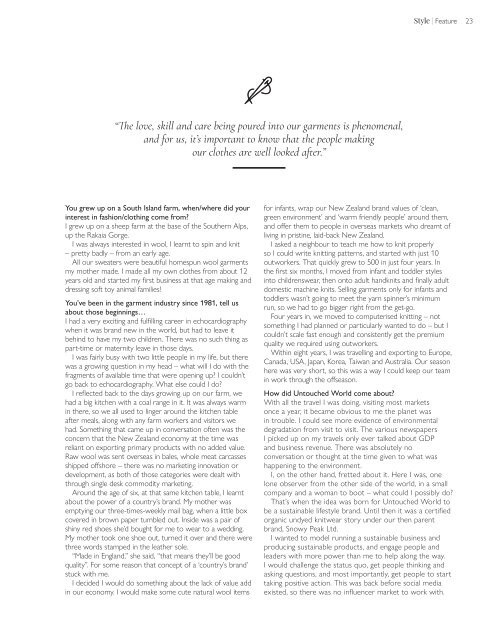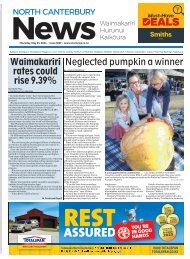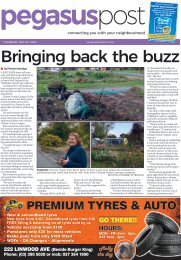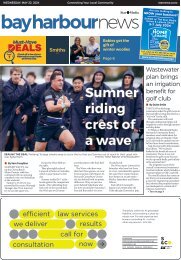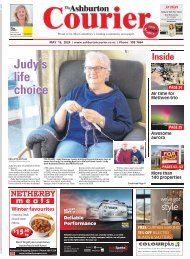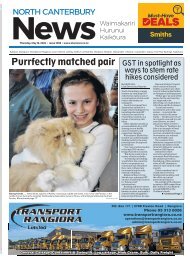Style: August 05, 2022
Create successful ePaper yourself
Turn your PDF publications into a flip-book with our unique Google optimized e-Paper software.
<strong>Style</strong> | Feature 23<br />
“The love, skill and care being poured into our garments is phenomenal,<br />
and for us, it’s important to know that the people making<br />
our clothes are well looked after.”<br />
You grew up on a South Island farm, when/where did your<br />
interest in fashion/clothing come from?<br />
I grew up on a sheep farm at the base of the Southern Alps,<br />
up the Rakaia Gorge.<br />
I was always interested in wool, I learnt to spin and knit<br />
– pretty badly – from an early age.<br />
All our sweaters were beautiful homespun wool garments<br />
my mother made. I made all my own clothes from about 12<br />
years old and started my first business at that age making and<br />
dressing soft toy animal families!<br />
You’ve been in the garment industry since 1981, tell us<br />
about those beginnings…<br />
I had a very exciting and fulfilling career in echocardiography<br />
when it was brand new in the world, but had to leave it<br />
behind to have my two children. There was no such thing as<br />
part-time or maternity leave in those days.<br />
I was fairly busy with two little people in my life, but there<br />
was a growing question in my head – what will I do with the<br />
fragments of available time that were opening up? I couldn’t<br />
go back to echocardiography. What else could I do?<br />
I reflected back to the days growing up on our farm, we<br />
had a big kitchen with a coal range in it. It was always warm<br />
in there, so we all used to linger around the kitchen table<br />
after meals, along with any farm workers and visitors we<br />
had. Something that came up in conversation often was the<br />
concern that the New Zealand economy at the time was<br />
reliant on exporting primary products with no added value.<br />
Raw wool was sent overseas in bales, whole meat carcasses<br />
shipped offshore – there was no marketing innovation or<br />
development, as both of those categories were dealt with<br />
through single desk commodity marketing.<br />
Around the age of six, at that same kitchen table, I learnt<br />
about the power of a country’s brand. My mother was<br />
emptying our three-times-weekly mail bag, when a little box<br />
covered in brown paper tumbled out. Inside was a pair of<br />
shiny red shoes she’d bought for me to wear to a wedding.<br />
My mother took one shoe out, turned it over and there were<br />
three words stamped in the leather sole.<br />
“Made in England,” she said, “that means they’ll be good<br />
quality”. For some reason that concept of a ‘country’s brand’<br />
stuck with me.<br />
I decided I would do something about the lack of value add<br />
in our economy. I would make some cute natural wool items<br />
for infants, wrap our New Zealand brand values of ‘clean,<br />
green environment’ and ‘warm friendly people’ around them,<br />
and offer them to people in overseas markets who dreamt of<br />
living in pristine, laid-back New Zealand.<br />
I asked a neighbour to teach me how to knit properly<br />
so I could write knitting patterns, and started with just 10<br />
outworkers. That quickly grew to 500 in just four years. In<br />
the first six months, I moved from infant and toddler styles<br />
into childrenswear, then onto adult handknits and finally adult<br />
domestic machine knits. Selling garments only for infants and<br />
toddlers wasn’t going to meet the yarn spinner’s minimum<br />
run, so we had to go bigger right from the get-go.<br />
Four years in, we moved to computerised knitting – not<br />
something I had planned or particularly wanted to do – but I<br />
couldn’t scale fast enough and consistently get the premium<br />
quality we required using outworkers.<br />
Within eight years, I was travelling and exporting to Europe,<br />
Canada, USA, Japan, Korea, Taiwan and Australia. Our season<br />
here was very short, so this was a way I could keep our team<br />
in work through the offseason.<br />
How did Untouched World come about?<br />
With all the travel I was doing, visiting most markets<br />
once a year, it became obvious to me the planet was<br />
in trouble. I could see more evidence of environmental<br />
degradation from visit to visit. The various newspapers<br />
I picked up on my travels only ever talked about GDP<br />
and business revenue. There was absolutely no<br />
conversation or thought at the time given to what was<br />
happening to the environment.<br />
I, on the other hand, fretted about it. Here I was, one<br />
lone observer from the other side of the world, in a small<br />
company and a woman to boot – what could I possibly do?<br />
That’s when the idea was born for Untouched World to<br />
be a sustainable lifestyle brand. Until then it was a certified<br />
organic undyed knitwear story under our then parent<br />
brand, Snowy Peak Ltd.<br />
I wanted to model running a sustainable business and<br />
producing sustainable products, and engage people and<br />
leaders with more power than me to help along the way.<br />
I would challenge the status quo, get people thinking and<br />
asking questions, and most importantly, get people to start<br />
taking positive action. This was back before social media<br />
existed, so there was no influencer market to work with.


